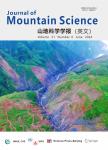Anatomical variation of five plant species along an elevation gradient in Mexico City basin within the Trans-Mexican Volcanic Belt, Mexico
Anatomical variation of five plant species along an elevation gradient in Mexico City basin within the Trans-Mexican Volcanic Belt, Mexico作者机构:Department of Botany Postgraduate College at Campus Montecillo Institute of Biology Autonomous National University of Mexico Center of Biological Research Autonomous University of State of Hidalgo Mineral de la Reforma
出 版 物:《Journal of Mountain Science》 (山地科学学报(英文))
年 卷 期:2017年第14卷第11期
页 面:2182-2199页
核心收录:
学科分类:0709[理学-地质学] 0819[工学-矿业工程] 07[理学] 0303[法学-社会学] 0708[理学-地球物理学] 0818[工学-地质资源与地质工程] 0705[理学-地理学] 0815[工学-水利工程] 0706[理学-大气科学] 0816[工学-测绘科学与技术] 0813[工学-建筑学] 0704[理学-天文学] 0833[工学-城乡规划学] 0713[理学-生态学] 0834[工学-风景园林学(可授工学、农学学位)]
基 金:support of the Instituto de Biología UNAM
主 题:Altitude Foliar anatomy Mount Tlaloc Wood anatomy Alchemilla procumbens Geraniumseemannii Cryptophyte Bimodal pattern
摘 要:Change in environmental conditions with altitudinal gradients induces morpho-anatomical variations in plants that have been poorly documented in intertropical regions. Five species with three life forms, cryptophyte(Alchemilla procumbens, Geranium seemannii), hemicryptophyte(Acaena elongata, Lupinus montanus), and phanerophyte(Symphoricarpos microphyllus), distributed along an altitudinal gradient in the Sierra Nevada of central Mexico, were studied. The aims were to identify and evaluate their morpho-anatomical modifications under the hypothesis that the sizes of individuals and of their wood and leaf cell types decrease as elevation increases. Three individuals per species per site were collected at seven locations along the altitudinal gradient(2949-3952 m). Their morpho-anatomical characters were analyzed through multiple regression analyses. Elevation was the variable that best explained anatomical changes in the leaf and wood ofthe five species. Canopy density and potassium content in the soil also contributed to explain the variation in anatomical variables along the gradient. As elevation increased a bimodal pattern was observed in various anatomical characters as in the leaf width of A. elongata, A. procumbens and G. seemannii and in the vessel diameter of A. procumbens, G. seemannii, and L. montanus. Other features as the vessel diameter of A. elongata, the fiber length of S. microphyllus, and the ray width of A. elongata increased as the elevation increased. Anatomical traits have a tendency to decrease in size but just toward the end of the gradient, which is probably related to changes in canopy density. The plant response to the altitudinal gradient is more focused on anatomical adaptations than morphological variation; it is also species dependent.



